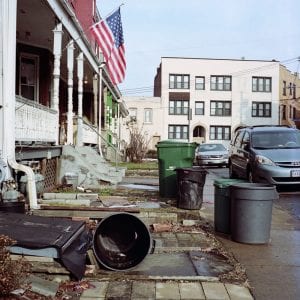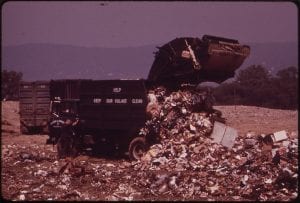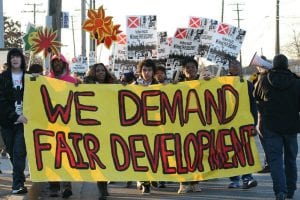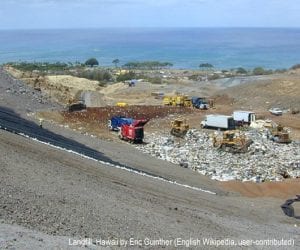In this article, we will explore the reasons why the waste caused by overconsumption is in fact a social justice issue. In particular, we will examine how the burden of waste disposal impacts low income, non-white communities in a disproportionate manner.
Whether it’s the stench of spoiled leftovers, or the eyesore of soiled napkins spilling onto the kitchen floor, the cues that let us know it’s time to take out the garbage are rarely subtle. And while taking out the trash can be a pain, once it’s out the door, the job feels done. Out of sight, out of mind.
Yes, we know trash doesn’t just disappear. Issues surrounding overconsumption have forced society to become more and more conscious of the garbage piling up in landfills and damaging our shared environment.
But the harm caused by solid waste mismanagement is not shared equally. Provided you live in the right zip code, the scope of the problem and your own contribution to it can be easy to ignore. But if landfills are being built down the street from your home, the problem certainly feels more urgent.
Which Communities Carry the Burden of Waste Mismanagement?
When it comes to municipal solid waste, the burden of pollution rests squarely on the shoulders of nonwhite and low-income communities. In the United States, race is the biggest predictor of an individual’s likelihood of living near hazardous waste sites. Housing policies like exclusionary zoning and redlining have concentrated black and brown populations into communities with restricted access to wealth and resources. These communities have historically been targeted for dumping waste and for siting landfills and trash incinerators.
Moreover, regulations put in place in the 1990s to reduce the number of local landfills led to a rise in private companies transporting commercial waste across state lines, which allowed for the continued targeting of marginalized populations. And whether the solid waste is coming from within a state or from various states across the nation, black and brown communities are the hardest hit.
More often than not, trash is transported into vulnerable areas where obstacles like food insecurity and lack of access to health care already limit quality of life. It is in these communities that the need for environmental justice is greatest. Because in neighborhoods where exposure to environmental harm is disproportionately large, the health consequences are as well.
Harmful Effects of Living Near a Landfill
Over 65% of trash in the United States either goes into landfills or incinerators. Once there, the trash interacts with the environment in a variety of ways that negatively impact human health.
Food waste and other organic matter comprise the largest portion of trash in landfills. As this decomposes, it creates off-putting odors, attracts disease-carrying rodents, and releases the greenhouse gas methane. Landfill gases have been associated with increased incidence of respiratory illnesses and various types of cancer. Additionally, all landfills will eventually leak toxins into the soil and groundwater. These toxins can contaminate sources of drinking water, and they stick around for years, threatening the health of nearby communities even after landfills are closed.
Communities Fighting for Environmental Justice
It’s not easy to site a landfill. They’re smelly, noisy and a blemish on the natural landscape. Communities with higher wealth and influence can rely on NIMBY opposition to block the construction of unwanted waste sites, but when low income and minority communities oppose construction, the fight is more demanding. Appeals to close sites that are actively causing damage are frequently ignored. But even in the face of such challenges, communities continue to mobilize and show resilience.
Take Houston, for example. Houston’s waste disposal facilities have consistently been sited in the city’s black neighborhoods. In 1967, protests broke out at the historically black Texas Southern University after a young child drowned in a nearby landfill that was not enclosed. Community protests continued, leading to the Sunnyside landfill closing in the 1970s. However, the closure of a landfill doesn’t mean the end of its threat to public health. In 2018, Sunnyside residents mobilized again—this time to stop construction of a community center on the old landfill. While the community center would have provided much needed resources, residents knew it didn’t belong on toxic land.
Though the journey has been long, the resolution of that battle looks promising. Last year, the land was approved to be used for a solar farm. Solar farms are considered a safe way to transform hazardous land into a productive resource that benefits locals.
In Baltimore, youth are leading the charge to improve the health of their communities. Students at Ben Franklin High School in Curtis Bay helped defeat a proposal that sought to build the country’s largest trash incinerator just a mile away from their school. The neighborhood celebrated this triumph, but residents know there is still more work to be done. Curtis Bay has one of the highest rates of air pollution in the country, yet the owners of the existing trash incinerators in Curtis Bay regularly push back against efforts to regulate sources of that pollution. Still, community members are steadfast in their efforts to create healthier neighborhoods. Ben Franklin High School developed environmental justice course material to enhance their students’ work as community activists, and residents continue to organize for change.
Looking Towards Waste Solutions for All
In the battle for social justice in solid waste management, the path forward is complex. Communities may look to reduce the harmful impact of landfills by purporting solutions like zero waste and trash reuse rather than focusing on disposal issues. These changes often occur as part of larger efforts to revive under resourced areas. And while neighborhood revitalization is positive, it brings with it the threat of environmental gentrification. As cities become more green, vulnerable populations are often displaced and further marginalized. To avoid this, it is essential that community efforts towards change intentionally center the needs of residents that would otherwise be displaced.
However, many groups are mobilizing in ways that suggest awareness of this issue. The organization that worked to stop the Curtis Bay incinerator, Free Your Voice, lists “development without displacement” as its current focus. Similarly, the solar farm to be constructed in Houston’s Sunnyside neighborhood will seek to improve the surrounding community by making power accessible to low income residents and creating local job opportunities.
To truly address issues connected to mismanagement of solid waste, it is necessary to recognize who is being harmed and to what degree. And efforts to build healthier communities should always begin with empowering those who are suffering the most.
Image credits: “Colors on the Street” by Michael Goodin is licensed under CC BY-NC-ND 2.0; “Dumping Garbage at the Croton Landfill Operation 08/1973” by The U.S. National Archives; “March to Stop the Incinerator” by United Workers is licensed under CC BY 2.0; “Long Island Solar Farm” by Brookhaven National Laboratory is licensed under CC BY-NC-ND 2.0








